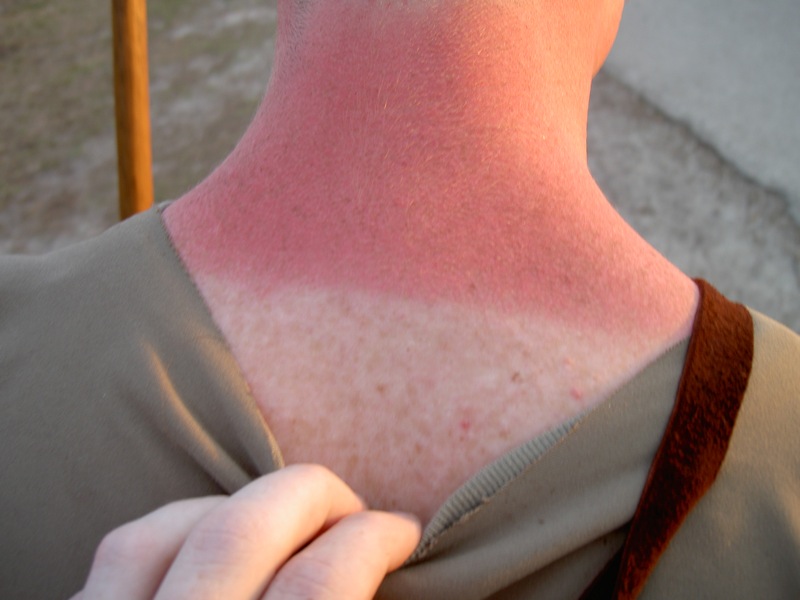What are the most effective ways of treating sunburn?
What is a sunburn?
Skin that has been sunburned is red, painful, and warm to the touch. Within a few hours of spending too much time in the sun, it frequently manifests.

Simple self-care procedures, such as taking painkillers and cooling the skin, can help you recover from a sunburn. But the sunburn could not go away for several days.
Everyone should take steps to protect their skin from the sun all year long by applying sunscreen and other skin-protection techniques. Even on chilly or overcast days, it is crucial when you’re outside.
Symptoms
Symptoms of sunburn include:
- On white skin, inflamed skin appears pink or red; however, it may be more difficult to discern on brown or black skin.
- the sensation of hot or heated skin
- Itching, discomfort, and pain
- Swelling
- small, potentially breakable blisters packed with fluid
- If the sunburn is severe, headache, fever, nausea, and exhaustion may result.
- eyes that are dusty or hurt
Any exposed body part, including the lips, scalp, and earlobes, is susceptible to burning. If, for instance, clothing has a loose weave that lets ultraviolet (UV) light through, even covered areas can burn. The eyes can burn as well because they are very sensitive to UV light from the sun.
After being exposed to the sun for a few hours, sunburn symptoms frequently develop. The top layer of the damaged skin may peel off within a few days as the body begins to mend itself. Healing from a severe sunburn could take several days. Any persistent alterations in skin tone often disappear with time.
Causes
Too much ultraviolet (UV) light exposure results in sunburn. Sunlight or man-made sources like sunlamps and tanning beds both produce UV light. The wavelength of light known as UVA can damage skin over time by penetrating to its deepest layers. Sunburn is brought on by UVB rays, which penetrates the skin more superficially.
Skin cells are damaged by UV radiation. Erythema, or inflamed skin, or sunburn, is a result of the immune system’s reaction, which involves increasing blood flow to the injured areas.
On chilly or cloudy days, sunburn is still possible. UV rays can reflect off of water, sand, and other surfaces, and they can also burn skin.
Diagnosis
A physical examination is typically part of the diagnosis of sunburn. Your doctor might also inquire about your signs and symptoms, prescriptions you’re taking, history of sunburns, and UV exposure.
Your doctor may advise phototesting if you experience sunburn or a skin reaction after only a brief period of exposure to the sun. In order to simulate the issue, measurable levels of UVA and UVB light are applied to small patches of skin during this test. You’re labelled sun-sensitive if your skin reacted to phototesting (photosensitive).
Treatment
Treatment for sunburns can reduce pain, swelling, and irritation but does not repair the skin. Your doctor could advise using a prescription corticosteroid cream if self-care measures fail to relieve your sunburn or it is extremely severe.
Lifestyle and home remedies
Use a painkiller.
As soon as you can following overexposure to the sun, take a nonprescription pain medication for pain management. Ibuprofen (Advil, Motrin IB, among others) and acetaminophen are two examples (Tylenol, others). You could also try applying a gel pain reliever to the area.
Skin cooling down.
Apply a clean cloth soaked with cool running water to the afflicted area of skin. Alternately, take a cool bath with 2 ounces (60 grammes) of baking soda added per tub. Several times per day, cool the skin for roughly 10 minutes.
Use a lotion, gel, or moisturiser.
Calamine lotion or an aloe vera gel might be calming. Before using, try putting the product in the refrigerator to cool it. Avoid anything alcoholic-related.
For a day, take in more water. By doing this, dehydration is avoided.
Be patient with blisters.
The skin might recover faster if the blister is intact. If a blister does rupture, use a pair of tidy, tiny scissors to remove the dead skin. Use mild soap and water to gently wash the area. The wound should then be dressed with an antibiotic cream and a nonstick bandage.
Gently handle skin that is flaking.
The impacted area may start to peel after a few days. This is how your body removes the top layer of unhealthy skin. Use moisturiser even if your skin is flaking.
Use an anti-itch medication.
As the skin starts to peel and repair underneath, an oral antihistamine such diphenhydramine (Benadryl, Chlor-Trimeton, other brands) may help to reduce itching.
Use a calming, medicinal cream.
Apply non-prescription 1% hydrocortisone cream to the affected region three times each day for three days if you have a mild to moderate sunburn. Before using, try putting the product in the refrigerator to cool it.
eye sunburn treatment.
Use a clean towel that has been soaked with cool running water. Contact lenses shouldn’t be worn until after ocular symptoms have subsided. Avoid rubbing your eyes.
Stop exposing yourself to the sun more.
Avoid the sun or utilise other sun protection techniques while your sunburn heals. You might want to try a product with sunscreen and moisturisers.
Avoid using products with the suffix “-caine,” such as benzocaine.
Such lotions may aggravate skin irritation or result in an allergic reaction. A rare but possibly fatal illness that reduces the quantity of oxygen that the circulation can carry has been connected to benzocaine (methemoglobinemia).
REFERENCES:
- https://www.mayoclinic.org/diseases-conditions/sunburn/symptoms-causes/syc-20355922
- https://www.mayoclinic.org/diseases-conditions/sunburn/diagnosis-treatment/drc-20355928
- https://www.aad.org/public/everyday-care/injured-skin/burns/treat-sunburn
- https://www.webmd.com/first-aid/sunburn-treatment
- https://www.parents.com/kids/safety/outdoor/sunburn-remedies/
For more details, kindly visit below.